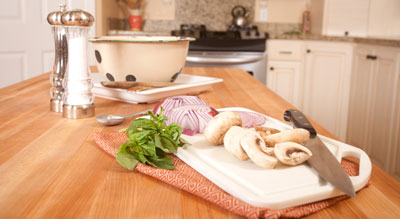Installing Butcher Block or Wood Countertops in a Kitchen
Butcher Block adds wonderful warmth to a kitchen. It works particularly well with painted or other solid color cabinets. This is a popular countertop choice for country kitchens and French country kitchens. It can be used throughout a kitchen, on an island or in a single area, such as the food prep, work area.
 |
Typically made from maple, oak, walnut or ash, these hardwoods provide a durable and warm surface. You can cut on a butcher block counter, but it will not resist all scratching. However, this surface has the advantage of being sandable, and resealable thus allowing removal of stains, cuts and other damage with light sanding.
Safety Concerns - The concern of some is that bacteria from raw meats and poultry will soak into the wood and cross contaminate other foods. Concerns over food safety and bacteria are largely unfounded. In reality, studies have shown that while some bacteria penetrates the surface, it does not multiply and eventually dies. The surface itself can be easily cleaned and made safely free of bacteria.
From a more practical viewpoint, most people will continue to use cutting boards, either wood or plastic, on top of their counters in order to preserve their appearance. The concern over knife cuts in the wood harboring bacteria become a non-issue. If uncooked meats were placed directly onto the counter, the protective finish will resist absorption of bacteria, and the countertop can simply be wiped clean.
Appearance - There are three styles of butcherblock, flat-grain, edge-grain and end-grain; in order of cost and durability. Flat-grain wood shows the grain of the wood and is more susceptible to damage from cutting and staining. Edge-grain wood displays less grain pattern and less prone to damage. End-grain is the classic style of butcher blocks and the most expensive. End-grain butcher block uses small cut-offs from a piece of wood, and joins the pieces together with the end-grain facing upward.
Wood countertops can be colored with wood stains or they can be left their natural color. The addition of mineral oil, which is necessary to maintain the wood, will darken the natural wood color a small amount. Wear and tear to wood countertops may be considered desirable as added character or it can be easily sanded smooth and a fresh coat oil added to restore a like-new appearance.
Durability - When cutting on end-grain hardwood counters, any cuts into the wood tend to close up behind the knife as it passes. Over time, wear can become evident in butcher block. However, butcher block has been used for centuries for good reason, it is easily restored to a like-new surface. Cuts and scratches can be easily sanded out to a new smooth surface. After sanding, typically an application of mineral or tung oil is rubbed in to fill the grain and a provide lustrous, protective finish. Each manufacturer may use their own formulation of sealant or finish, so be sure to use the refinishing material recommended by your counter's manufacturer.
Butcher block is very prone to discoloration from water. Water can soak into the countertop if allowed to stand. Spills should be wiped up promptly. Rings can result from wet glasses, bottles or dishes left on the counter. Rings and water marks can be removed by light sanding and reapplication of oil or other recommended finish.
When installed over a dishwasher, wood counters may be exposed to heat, moisture and steam. Make certain that the dishwasher is adequately insulated to minimize the influence of heat. Some manufacturers recommend the installation of a foil or other membrane under the counter to protect the wood from heat and moisture. Some dishwasher vent moisture of steam out the front of the dishwasher. The steam could result in damage to the edge or underside of the countertop. To avoid this, choose a model that does not vent moisture near the countertop or by installing the dishwasher in way to minimize this risk.
Installing butcher block around a sink can be problematic. Because of splashing and wet dishes set on the counter, there is a lot of potential for staining and a small chance of physical damage, such as delamination in extreme cases. If the sink opening is cut by the manufacturer and then sealed, the likelihood of problems may be reduced. If the a hole is cut by your installer, then make certain they apply liberal amounts of sealer or finish to the edges and underside of the wood all the way around the sink. A continuous bead of silicone caulk should also be used between the wood and a sink.
Maintenance Requirements - Butcher block maintenance is fairly easy and can be done by a homeowner. Counters can be wiped clean with a rag wetted with warm soapy water. Use of vinegar as a cleaner is effective for killing germs and disinfecting the counters. Periodic application of mineral oil or tung oil or other recommended finish will maintain the luster and moisture resistance of the wood. Reapplication of mineral oil (or whatever is recommended by the manufacturer) typically has to be done every 3 to 6 months, though it is very easy to do.
Cost - Butcher block and wood countertops range from $50 to $200 per square foot, including installation. The wood species, the countertop thickness, grain type and edge detailing all influence the price.
| Countertop Articles | ||||||||||||||||||
Getting the Best prices on Countertops |
Countertop Gallery |
|||||||||||||||||
| Countertop Materials |
|
|||||||||||||||||
|
|
|






